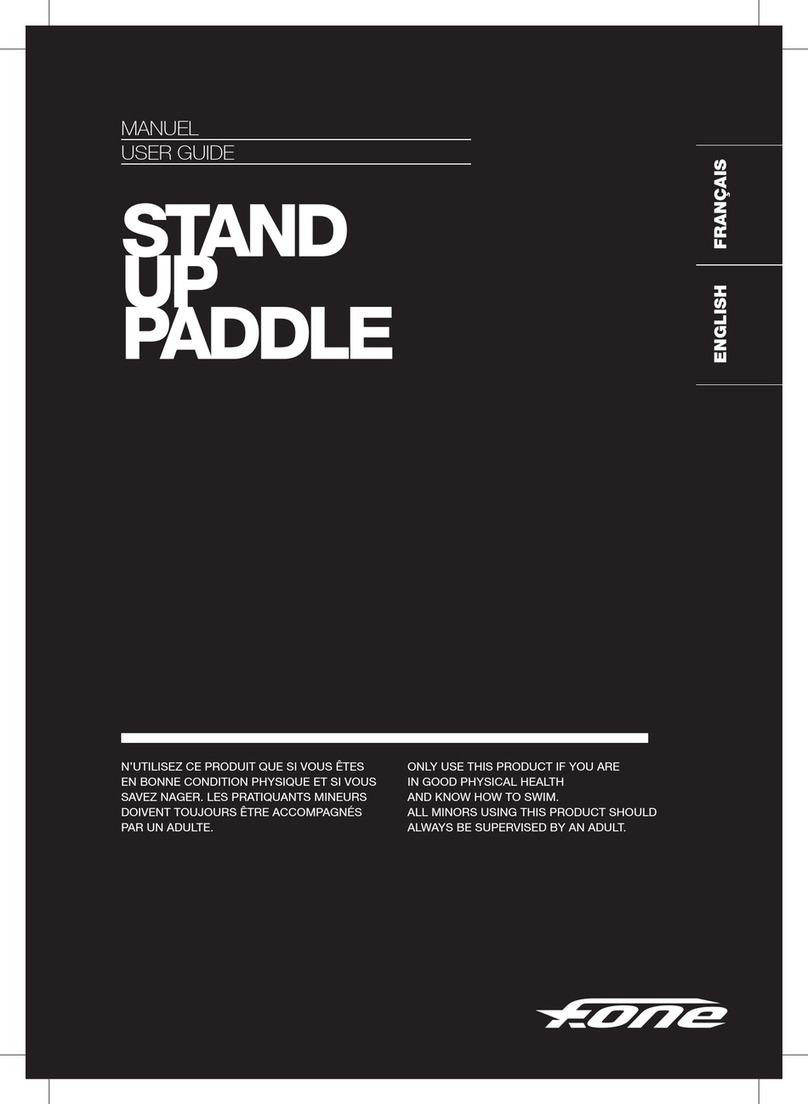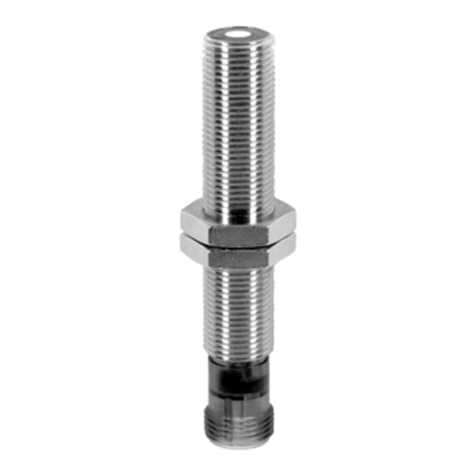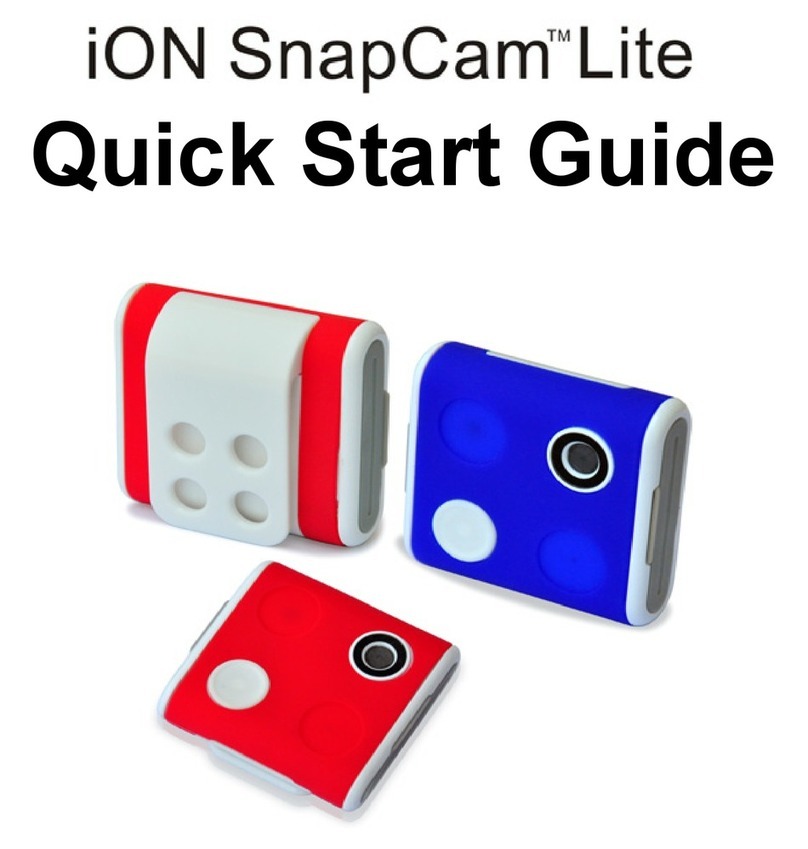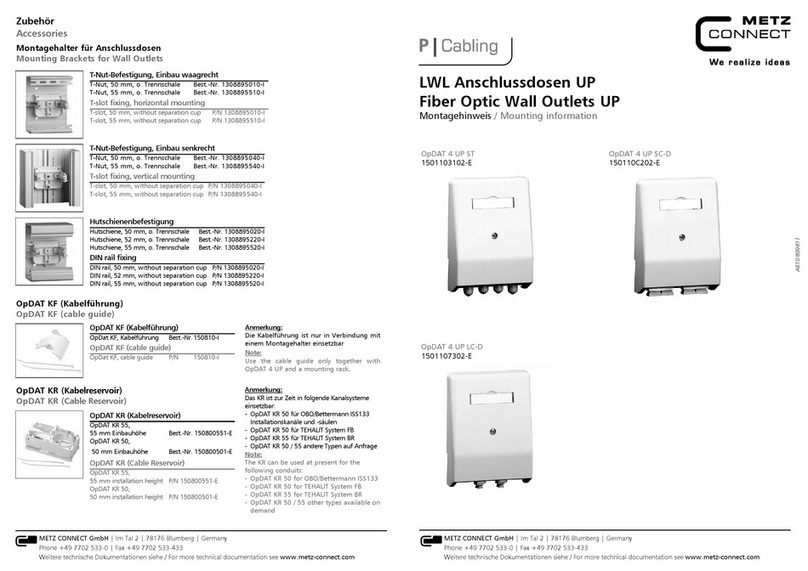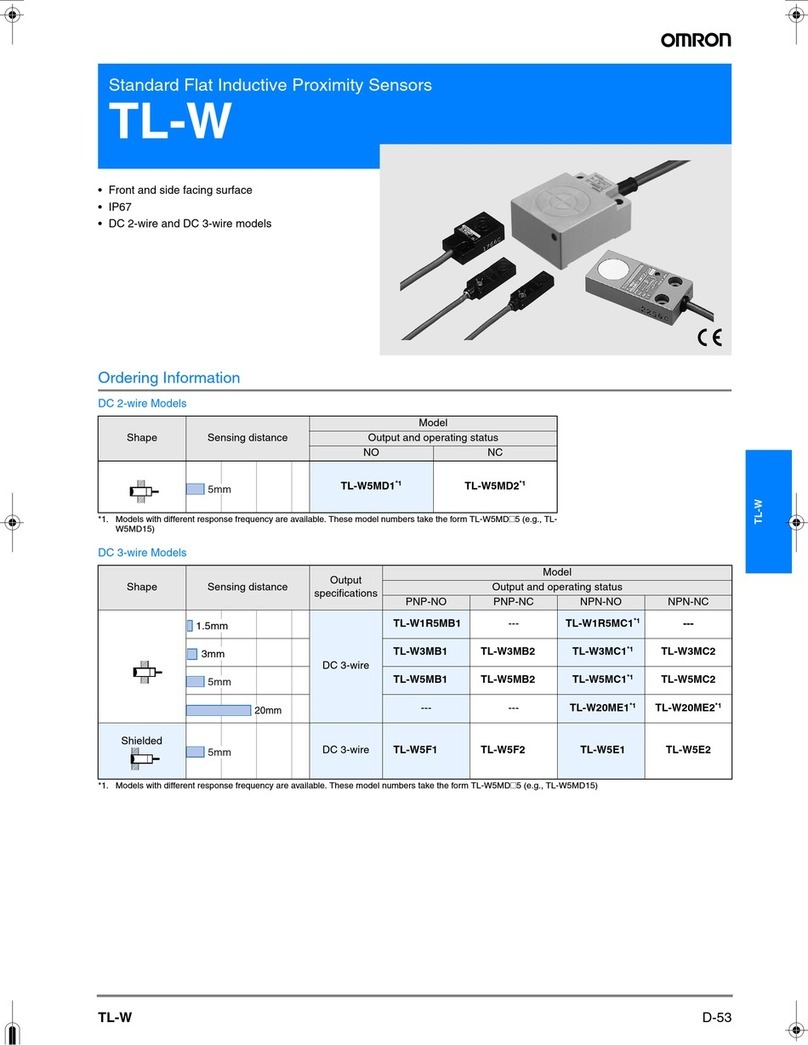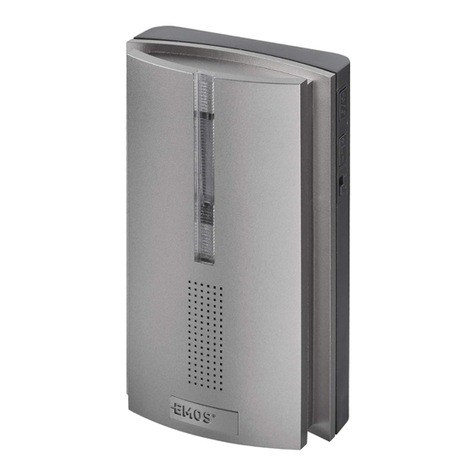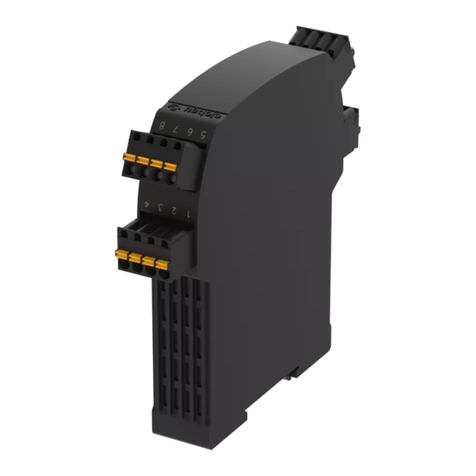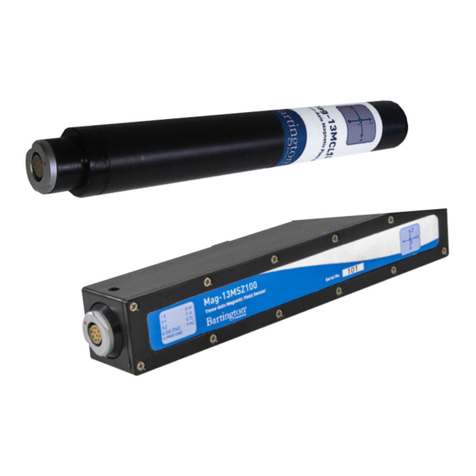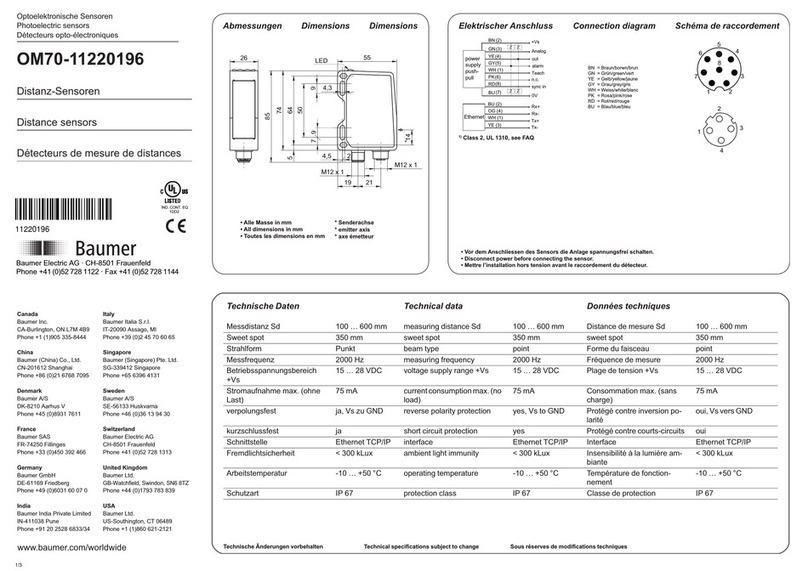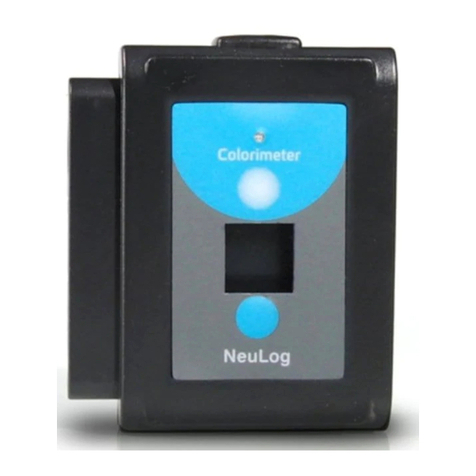Fone HYDROFOIL LEVO CARBON User manual

HYDROFOIL
GRAVITY CARBON
LEVO CARBON
FRANÇAISENGLISH
MANUEL
USER GUIDE
LA PRATIQUE DE L’HYDROFOIL COMPORTE
CERTAINS RISQUES ET PEUT CAUSER
DES ACCIDENTS GRAVES. LISEZ ATTENTIVEMENT
CE MANUEL AVANT D’UTILISER CE FOIL.
USING A HYDROFOIL INVOLVES RISKS
AND CAN CAUSE SEVERE INJURIES.
CAREFULLY READ THIS MANUAL
BEFORE USEYOUR GEAR.

23
FRANÇAISENGLISH
L’utilisation d’un hydrofoil comporte certains
risques et peut causer des accidents graves ou
mortels. C’est pourquoi il est vivement conseillé
de suivre une formation préalable dans une école
spécialisée avant toute première utilisation.
Pour trouver l’école la plus proche de chez vous,
rendez-vous sur : fr.f-one.world/revendeurs/
Avant toute pratique, vériez que vous disposez
d’une assurance couvrant votre responsabilité
civile pour la pratique concernée et des garanties
sufsantes pour les risques d’accident corpo-
rel personnel (sans tiers responsable). Rappro-
chez-vous de votre fédération sportive pour plus
de renseignements.
AVANT D’UTILISER VOTRE FOIL, LISEZ ATTENTIVEMENT CE MANUEL ET CONSER-
VEZ LE POUR UNE CONSULTATION ULTÉRIEURE.
L’équipement (casque, gilet, ...) contribue à votre sécurité mais ne dispense pas de la prudence et de
l’attention. Rappelez-vous que personne ne peut contrôler son hydrofoil à 100%.
Ne partez jamais naviguer seul. Il est conseillé de pratiquer en présence d’une personne qui pourra en cas
d’incident prévenir des secours.
Le casque
Le casque est conseillé pour vous protéger lors des chutes mais il vous sauvera également dans d’autres
conditions inattendues.
La combinaison
Choisissez une combinaison intégrale (eau<19°) ou un shorty (eau>19°) selon la température de l’eau. Sachez
que lorsque vous avez froid, vous consommez plus d’énergie.
Le gilet de protection
Le gilet peut faciliter votre évolution dans l’eau. Vous serez également content de le porter pour amortir vos
mauvaises chutes. C’est aussi un très bon compagnon de galère lorsqu’il faut rentrer à la nage.
VOICI QUELQUES RÈGLES DE SÉCURITÉ À CONNAÎTRE ET À RESPECTER
Choisissez votre spot en fonction de votre niveau
Le choix du spot est primordial pour un apprentissage en sécurité. Le bon spot n’est pas forcément celui où il y
a le plus de pratiquant. Choisissez un endroit où vous pourrez évoluer sans devoir éviter la trajectoire d’autres
personnes. Il est important de choisir un spot adapté à la pratique du foil, c’est à dire un endroit peu agité avec
une profondeur d’eau plus importante et sans récifs.
L’orientation du vent
Méez-vous du vent offshore si vous n’avez pas de bateau d’assistance. Dans ces conditions, il est plus dif-
cile de rentrer à la nage à cause du vent et du courant qui poussent vers le large. Plus généralement, anticipez
l’effet du vent et du courant qui peuvent vous faire dériver vers le large, vers la plage ou le long de la plage.
RÈGLE N°1 - VOTRE SÉCURITÉ
RÈGLE N°2 - ÉQUIPEZ-VOUS
RÈGLE N°3 - CHOISISSEZ VOTRE LIEU DE PRATIQUE
RÈGLES DE SÉCURITÉSOMMAIRE
TABLE OF CONTENTS
RÈGLES DE SÉCURITÉ 3
∙ Votre sécurité 3
∙ Équipez-vous 3
∙ Choisissez votre lieu de pratique 3
∙ Vériez les conditions météorologiques 4
∙ Respectez et aidez les autres 4
DÉCOUVRIR VOTRE FOIL 5
∙ Principe du foil 5
MONTER / DÉMONTER LE FOIL 6
∙ Pour assembler le foil 6
∙ Pour monter le foil sur la planche 6
∙ Pour démonter le foil 6
UTILISER LE FOIL 7
PRÉCAUTIONS & ENTRETIEN / PIÈCES DÉTACHÉES & GARANTIE 8
SAFETY 10
∙ Your own Safety 10
∙ Get set up 10
∙ Choose your practice spot 10
∙ Check the weather conditions 11
∙ Help out others 11
GET TO KNOW THE GRAVITY FOIL 12
∙ Foil principles 12
ASSEMBLING / TAKING APART THE FOIL 13
∙ Assembling the foil 13
∙ Fitting the foil onto the board 13
∙ Taking the foil apart 13
∙ Using the foil 14
USING THE FOIL 14
CARE & MAINTENANCE 14
SPARE PARTS & GUARANTEE 15

45
FRANÇAISENGLISH
Respectez les zones de navigation
Le foil se pratique au-delà de la bande des 300
mètres et jusqu’à un mille d’un rivage accessible. Le
foil doit être pratiqué à l’intérieur de la zone des 300
mètres avec précaution et en tout cas à une vitesse
inférieure à 5 nœuds sauf dérogation accordée par la
Préfecture Maritime.
La pratique du foil est interdite dans les zones de bai-
gnade et plus généralement dans toute zone réser-
vée à une autre activité. Renseignez-vous auprès du
club gestionnaire du site ou des pratiquants locaux
des règles locales spéciques.
Informez-vous sur la météo avant d’aller
naviguer (téléphone, web, capitainerie)
Quelle sont les conditions de vent et de vagues
annoncées? Vous devez savoir comment la force
et la direction du vent et des vagues vont évoluer
au cours de la journée. Renseignez-vous sur les
horaires de marées et les zones de fort courant.
Lors d’une pratique aérotractée, le foil permet de
naviguer dans des conditions marginales. Il faut
donc faire attention au risque que le vent tombe
complètement. Ne partez pas sur l’eau par temps
orageux.
Aidez les autres
Soyez toujours attentifs aux autres pratiquants, n’hé-
sitez pas à proposer votre aide ou encore aller aider
un pratiquant en difculté.
Respectez le public
Ne conez pas votre matériel à une personne qui n’a
jamais pratiqué. Si vous utilisez une aile de kite, met-
tez en garde les spectateurs du danger potentiel à
rester sous le vent des pratiquants.
LES FOILS SE COMPOSENT DE PLUSIEURS
PARTIES DISTINCTES:
La forme du prol des ailes ne doit pas être modiée, enduite ou poncée, au risque de perturber l’équilibre et
le fonctionnement du foil.
ATTENTION
An de garantir l’agrément d’utilisation et les performances, le bord arrière des ailes (bord de
fuite) doit rester très n ce qui rend cette partie plus fragile aux chocs. Lors des manipulations
et de l’utilisation du foil, il est également nécessaire de faire attention à ces zones affûtées an
d’éviter tout risque de blessure.
Les ailes avant et arrière fonctionnent comme des plans porteurs, c’est-à-dire qu’elles créent une force de
portance au contact de l’eau qui s’écoule autour d’elles avec de la vitesse. C’est la raison pour laquelle les
ailes reçoivent un prol spéciquement étudié.
Mast top plate
1 Top plate
2 Vis M6 - 25 mm (x2)
Alu mast
3 Prol aluminium
Titan mast foot
4 Pied de mât aluminium
5 Vis M6 - 25 mm (x2)
Front wing
6 Aile avant carbone
7 Fuselage arrière carbone
8 Vis M6 - 25 mm (x2)
9
GRAVITY Carbon : vis M6 - 32 mm (x3)
LEVO Carbon : vis M6 - 38 mm (x3)
10 Vis M6 - 16 mm (x2)
Stabilizer
11 Stabilisateur carbone
RÈGLE N°4 - VÉRIFIEZ LES CONDITIONS MÉTÉOROLOGIQUES
RÈGLE N°5 - RESPECTEZ ET AIDEZ LES AUTRES
PRINCIPE DU FOIL
ATTENTION
RÈGLES DE SÉCURITÉ DÉCOUVRIR VOTRE FOIL
Produit présentant des parties affûtées.
Risque de blessure. Port du casque et d’un gilet
de protection fortement recommandé.
Lors d’une chute, le foil et la planche peuvent conser-
ver leur vitesse un certain temps avant de s’arrêter.
Attention aux risques d’impact. L’ensemble foil +
planche peut dériver à une vitesse supérieure à celle
d’une planche seule. Ne pas laisser le foil dans l’eau
sans attention pendant trop longtemps au risque de
le voir s’éloigner rapidement.
Le foil ajoute du poids et de l’encombrement à la
planche. Lorsqu’il est immergé, le foil produit une
plus grande force d’opposition à la dérive liée à la
force du kite. La planche ne glisse pas aussi faci-
lement qu’une planche sans foil. Les manipulations
dans l’eau doivent se faire de manière douce et
contrôlée. Attention aux mouvements brusques.
1
3
4
5
6
7
10
11
9
8
2

67
FRANÇAISENGLISH
7
Posez la planche à l’envers (carène vers le haut).
8 Fixezl’ensemble du foil sur la planche à l’aide de quatre vis M6 x 25 mm et des écrous spéciaux (T-nut).
Dans le cas où vous utilisez un boitier Tuttle, KF ou Deep-KF:
7
Posez la planche à l’envers (carène vers le haut).
8Insérez le talon du foil dans le boitier prévu dans la carène.
9Basculez la planche sur la tranche avec précaution.
10 Fixez le foil à la planche en utilisant deux vis M6 de longueur adaptée à votre planche.
N’oubliez pas d’utiliser des rondelles assez larges pour ne pas endommager le pont de la planche.
1
Fixez sur votre mât la tête de mât (top plate) a l’aide de deux vis M6 x 25 mm.
Dans le cas où vous utilisez un boîtier Tuttle, KF ou Deep-KF:
1 Fixez votre boîtier sur le mât avec deux vis M6 x 50 mm.
2Vissez le pied de mât TITAN (mast foot) sur le mât avec deux vis M6 x 25 mm
(passez cette étape s’il s’agit d’un mât carbone).
3Assemblez l’aile avec la partie arrière du fuselage avec deux vis M6 x 25 mm.
4 Fixez le stabilisateur sur le fuselage avec deux vis M6 x 16 mm.
5Fixez l’ensemble de l’aile sur le mât avec :
aile GRAVITY Carbon : 3 vis M6 x 32 mm
aile LEVO Carbon : 3 vis M6 x 38 mm.
6 Serrez fermement jusqu’à obtenir un ensemble monobloc sans pour autant risquer d’abîmer les têtes de vis.
1
Placez l’ensemble foil + planche assemblée à l’envers.
2Dévissez l’aile avant en laissant le mât connecté à la planche.
3Dévissez le stabilisateur du fuselage et démontez l’aile.
4Dévissez la platine ou le boîtier et retirez le mât de la planche.
Dans le cas où vous utilisez une tête de mât top plate:
4Basculez d’abord la planche sur la tranche avec précaution puis dévissez et retirez le mât de la planche.
5N’oubliez pas de rincer l’ensemble de pièces après utilisation.
POUR ASSEMBLER LE FOIL
POUR MONTER LE FOIL SUR LA PLANCHE
POUR DÉMONTER LE FOIL
MONTER / DÉMONTER LE FOIL
DE PART SES DIMENSIONS ET SON POIDS,
LE FOIL CHANGE TOTALEMENT
LE COMPORTEMENT DE LA PLANCHE
SUR TERRE COMME EN MER.
Manipulation à terre
Lorsqu’il est assemblé avec la planche, veiller à
toujours poser l’ensemble sur la tranche au risque
de voir la planche basculer avec le foil. Ne pas
laisser le foil (lorsqu’il est monté sur la planche)
posé à l’endroit ou à l’envers. Il risquerait de bas-
culer et de s’endommager.
Mise à l’eau, retour à terre
Pour la mise à l’eau, veillez à porter le foil sur le
côté et à saisir l’ensemble en portant la planche
sous le bras ou par sa poignée en saisissant le foil
par l’autre main.
• Marcher dans l’eau en gardant la planche sous le
bras (planche couchée sur le côté).
• Avancer jusqu’à atteindre une profondeur supé-
rieure à la hauteur du foil. Attention, une marge
de sécurité est nécessaire car la planche et le foil
s’enfoncent lorsque le rider monte sur la planche.
• An d’éliminer tout risque d’impact avec un haut
fond, il est fortement recommandé de s’éloigner du
bord en gardant la planche et le foil sur la tranche
jusqu’à atteindre une zone ou la profondeur de
l’eau est sufsante et sécurisante.
• Lors du retour à terre, il est nécessaire de des-
cendre de la planche à la même distance du bord
qui a été nécessaire pour la mise à l’eau, avant de
se rapprocher du bord. Lors de ces phases, gardez
la planche et le foil dans la position couchée.
UTILISER LE FOIL

89
FRANÇAISENGLISH
PRÉCAUTIONS & ENTRETIEN
PIÈCES DÉTACHÉES
Les pièces détachées indispensables à l’utilisation des produits sont disponibles auprès de F-ONE ou de
votre revendeur. Ces pièces sont généralement disponibles pendant 3 ans à compter de la 1ere mise au
catalogue du produit. Des délais plus courts ou plus longs peuvent s’appliquer selon les produits. Pour tous
renseignements, contactez votre revendeur. Notez soigneusement le numéro de série du produit, il vous
servira pour identier le produit, en cas de de SAV ou en cas de vol.
POUR TOUTE PRISE EN CHARGE DE GARANTIE,
ADRESSEZ-VOUS EN PREMIER LIEU
À VOTRE REVENDEUR.
Cette garantie ne couvre pas les dommages occasionnés par:
• Une négligence ou une mauvaise utilisation, notamment les dommages liés à un impact de toute par-
tie de l’hydrofoil avec le fond marin, récif ou autres éléments intégralement ou partiellement submergés.
• Une modication d’un élément de l’équipement,
• Une exposition excessive au soleil, à la chaleur ou au froid,
• Un mauvais stockage et/ou entretien du matériel,
• Une utilisation du matériel dans du shore break, ou tous dommages autres que ceux résultant d’un défaut
de fabrication ou de matériau.
GARANTIE
Après chaque utilisation, veiller à toujours:
• Démonter l’aile avant, le fuselage
et autres pièces du mât.
• Nettoyer et rincer l’ensemble des pièces
composant le foil avant de les ranger.
• Protéger les pièces en les rangeant
dans l’emballage d’origine ou une autre
protection adaptée.
Veillez à garder un aspect de surface propre et
lisse. Le foil fonctionne en équilibre dynamique et
l’écoulement autour des plans porteurs et du mât
peut être sensible aux imperfections. Des risques
de décrochement déséquilibrant l’utilisateur et de
chutes soudaines sont possibles si l’état de surface
des différentes parties est trop endommagé. En cas
d’aspérités supercielles après un choc, combler
avec une résine ou un mastique époxy et poncer
jusqu’à retrouver un état de surface propre et lisse.
Il est recommandé de coner la réparation à un pro-
fessionnel.
Les produits F-ONE sont garantis selon les
lois en vigueur contre tout défaut majeur.
F-ONE garanti ce produit de tout défaut majeur de
fabrication ou de matériau pour une période d’un an
à compter de sa date d’achat.
Cette garantie est soumise aux clauses limitatives
suivantes : la garantie n’est valide que si le produit
est utilisé dans des conditions normales d’utilisation
mais ne couvre pas le produit si il est mis en location.
F-ONE se réserve le droit de déterminer souveraine-
ment de la prise en garantie ou non par un contrôle
visuel (photos du matériel) montrant clairement le(s)
défaut(s).
Si nécessaire, cette information pourra être envoyée
au distributeur F-ONE de votre pays. Le produit pour-
ra être retourné uniquement après délivrance d’un
numéro de retour SAV par votre distributeur F-ONE.
La facture d’origine doit être jointe à toute demande
de prise en garantie. Le nom du magasin et la date
d’achat doivent y être clairement lisibles. Si ce produit
est déclaré défectueux par F-ONE, la garantie couvre
la réparation ou le remplacement du produit défec-
tueux uniquement. F-ONE n’est pas responsable du
coût supplémentaire, de la perte ou des dommages
résultants d’une mauvaise utilisation de ce produit.

FRANÇAISENGLISH
10 11
Navigation areas & local regulations
Foiling is normally practiced outside of the 300
m area and within one nautical mile from a safe
shore. When practiced within the 300 m area foiling
should be performed with care and with a maxi-
mum speed of 5 kts unless specically authorised
by the authorities.
Foiling is forbidden within the swimming areas and
more generally in any area dedicated to a specic
activity. Get some information from the local club,
authorities or from other users on the specic local
regulations.
What are the forecasts for wind and waves for the
day? You need to know how the strength and direc-
tion of the wind and waves will evolve along the day.
Check on the tide schedules and on the areas of rip
and strong currents.
When using a kite or another wind propelled device,
the foil can let you ride in marginal conditions. Keep
in mind the wind can quickly die completely. Do not
go out on the water during thunder and lightning.
Help out others
Always keep an eye on your surroundings, and pay
attention to others. Do not hesitate to help out or go
after a struggling kitesurfer.
Respect bystanders
Do not lend your equipment to somebody that has
never practiced before. When using a kite, inform the
spectators of the potential risk of staying downwind
from a kitesurfer.
RULE N°4 - CHECK THE WEATHER CONDITIONS
RULE N°5 - RESPECT & HELP OUT OTHERS
WARNING
Product presenting sharp areas - Risk of injuries
Protection helmet and impact vest are strongly
recommended during use.
When falling, the board and foil can keep their pace
for some time before stopping. Beware of impacts.
The board and foil can drift away at higher speed
than a normal single board. Do not leave your foil
unattended in the water for too long or it could
drift far away from you rapidly.
The foil modies the weight and size of the board.
When immerged, the foil generates more force op-
posing the drifting force of the kite. The board does
not slide on the water the same way as a single
board. Handling movements should be soft and
controlled. Beware any hasty or abrupt movement.
Using a hydrofoil involves inherent risks and can
cause severe injuries or, sometimes fatal, acci-
dents if misused. F-ONE therefore strongly recom-
mends to follow lessons in a specialized school
before using a hydrofoil for the rst time.
To nd your nearest school, please check our web-
site at: www.f-one.world/dealers/
When using a hydrofoil, you agree to take full res-
ponsability for your safety and those of others, which
inculdes informing sebsequent users/owners of your
equipment of the risks and responsabilities involved.
before practicing, make sure that you are properly
convered by an insurrance for any damage or in-
juries caused to third parties while practicing your
sport. Please refer to your sporting federation to get
more information on insurrance and responsabilities.
READ CAREFULLY THIS MANUAL BEFORE USING YOUR KITE AND KEEP IT
STORED FOR FUTURE READING
Specialized equipment contributes to your own safety but do not exempt from constant care and caution.
Please keep in mind that wind and weather can be unpredictable and that no-one can be in full control of the
hydrofoil all the time.
You should never go riding alone. It is strongly recommended to practice in the company of other users who
could eventually call for assistance or help in case of emergency.
Helmet
It is strongly recommended to wear a helmet to protect you in case of a fall or any other unexpected situation.
Wetsuit
Choose a full-length wetsuit (water T° <19°C) or a shorty (water T°>19°C) depending on the water temperature.
Be aware that you will use more energy when you are cold.
Impact vest
The impact vest can help your evolution when being in the water. It might also be welcome when falling gard
and will become your new bast-mate if you ever have to swim back to shore
A FEW SAFETY TIPS TO KNOW AND FOLLOW
Observe local laws and regulations regarding kitesurf and the usage area.
Choose your spot according to your level
The choice of a good spot is a prerogative for a safe learning. The best spot is not necessarily the place where
you nd the most riders/users. Choose a place where you can learn safely without having to constantly adapt
to other people around you. It is important to choose a place adapted to foiling, favor a place that isn’t choppy
or turbulent, with enough water depth and without reefs or shoals.
Wind direction
Beware from offshore winds if you have no assistance. In these conditions it is more difcult to swim back to
shore because of the wind and current pushing away from the beach. More generally, you need to anticipate
the effect of the wind and tide/current which can make you drift away, towards or along the shore.
RULE N°1 - YOUR OWN SAFETY
RULE N°2 - GET SET UP
RULE N°3 - CHOOSE YOUR PRACTICE SPOT
SAFETY

FRANÇAISENGLISH
12 13
7 Lay down the board bottom facing up.
8 Connect the foil to the board using four of the M6 x 25 mm screws and the T-nuts provided.
If your board requires a Tuttle, KF or Deep-KF connection:
7
Lay down the board bottom facing up.
8Insert the mast head into the box of the board.
9Rotate carefully the board onto its side.
10 Fasten the foil to the board using two M6 bolts. Make sure the bolts you use are the right length for your
board. Do not forget to use washers to avoid damaging the deck of the board.
1
Fit the top plate onto the mast using two of the M6 x 25 mm screws (see here under if you are using
another top part to connect the foil to your board).
If your board requires a Tuttle, KF or Deep-KF connection:
1 Fit the required top part onto the mast using the two M6 x 50 mm screws.
2Fit the TITAN mast foot onto the mast using two of the M6 x 25 mm screws
*(skip this step when using a carbon mast).
3Assemble the foil plane together (wing + fuselage tail) with two M6 x 25 mm screws
4Fit the foil plane onto the mast with the following screw set:
GRAVITY Carbon: 3x screw M6 x 32 mm
LEVO Carbon: 3x screw M6 x 38 mm
6 Tighten all screws rmly until a rigid connection is achieved throughout the foil.
Do not over tighten to the point of damaging the screw heads.
1 Put the foil + board upside down on the ground.
2Unscrew the plane, leaving the mast on the board.
3Unscrew the stabilizer and take the plane apart.
4Unscrew the plate or the mast head and take away the mast from the board.
If you are not using a top plate :
4Put the board on its side to unscrew the mast from the board before taking it off.
5Do not forget to rince all the parts after use.
TO ASSEMBLE THE FOIL
FITTING THE FOIL ONTO THE BOARD
TO TAKE THE FOIL APART
ASSEMBLING / TAKING APART THE FOIL
THE FOIL IS MADE SEVERAL DISTINCT PARTS:
The shape of the wings’ profile shall not be modified, filled and sanded. Doing so would alter the
balance and prevent the correct operation of the foil.
WARNING
In order to guarantee the correct behavior and performances of the foil, the rear edge (trailing
edge) of the wings must remain very thin, thereby making this part more fragile in case of
impacts. During handling and use of the FOIL, the user should be particularly cautious with
these sharp areas in order to avoid any risk of injury.
The front and rear wings work as lifting devices, which means they can create a lifting force from the ow of
water that travels across them at speed. This is the reason why they are built with a specic sectional prole:
Mast top plate
1 Top plate
2 M6 - 25 mm Screws (x2)
Alu mast
3 Aluminium prole
Titan mast foot
4 Aluminium mast foot
5 M6 - 25 mm Screws (x2)
Front wing
6 Carbon front wing
7 Carbon fuselage tail
8 M6 - 25 mm Screws (x2)
9
GRAVITY Carbon: M6 - 32 mm screw (x3)
LEVO Carbon: M6 - 38 mm screw (x3)
10 M6 - 16 mm Screws (x2)
Stabilizer
11 Carbon stabilizer
FOIL PRINCIPLE
GET TO KNOW
ABOUT YOUR FOIL 1
3
4
5
6
7
10
11
9
8
2

FRANÇAISENGLISH
14 15
WITH ITS ADDED DIMENSIONS AND
WEIGHT, THE FOIL SIGNIFICANTLY
CHANGES THE BEHAVIOR OF THE
BOARD BOTH ON SHORE AND
IN THE WATER.
Handling on shore
When left on the ground the foil should always
be laid on its side otherwise it might tip over.
Never leave the foil (assembled with the board)
standing up or upside down. It can easily fall on
its side and get damaged.
HandlingIn the water
When heading for the water, the foil and
board should always be carried on its side
with the board held under your arm or by
the handle with your other hand holding di-
rectly the foil if necessary.
• Walk in the water while keeping your board
and foil on the side.
• Go deeper into the water until reaching a wa-
ter patch deep enough for the size of the foil.
Warning: a safety margin is required as the
board and foil will sink to some degree when
the rider gets onto the board.
• When heading back to the shore, it is ne-
cessary to get down from the board at the
same distance from the shore that had been
required to start safely. During these phases,
the board and foil should remain on their side.
The spare parts required for the correct use of our products are available from F-ONE or your local dealer.
These parts are usually available for 3 years following the 1st introduction of the product on the market. Shorter
or longer delays can apply depending on the product. For any information, contact your dealer. Carefully write
down your product serial number. I will come handy to identify the product, for after-sale issues or in case
your gear gets stolen.
SPARE PARTS
CARE & MAINTENANCE
USING THE FOIL
FOR ALL WARRANTY CLAIMS,
CONTACT YOUR DEALER FIRST.
GUARANTEE
F-ONE products are guaranteed according to
the laws in force against any major defect.
This warranty is subject to the following limiting
clauses:
The warranty is valid only if the product is used under
normal conditions of use and excludes the use for
rental. F-ONE reserves the right to determine whether
or not the guarantee is covered by a visual inspection
(photo or visual inspection of the equipment) clearly
showing the defect(s).
If necessary, this information may be sent to the F-ONE
distributor in your country. The product may be re-
turned only after the issue of a customer service return
number by your F-ONE distributor. The original invoice
must be attached to any warranty claim. The name of
the store and the date of purchase must be clearly le-
gible. If the product is declared defective by F-ONE, the
warranty covers the repair or replacement of the de-
fective product only. F-ONE is not responsible for any
additional cost, loss or damage resulting from misuse
of this product.
This warranty does not cover damage caused by
• Misuse (including any damage caused by an impact of any part of the hydrofoil with the sea bed, reef, shoal,
or any other element),
• Abuse, neglect or normal wear and tear,
• Any alteration of the original equipment,
• Damage due to excessive sun exposure or to winds on the beach,
• Damage caused by improper handling and storage,
• Damage caused by use in shore break,
• Damage caused by anything other than defects in material and workmanship.
Following every use, make sure you always
• Take appart the front wing, fuselage
and other parts from the mast.
• Clean and rinse all the parts of the foil
before storing them.
• Protect the parts by storing them in their
original packaging or using another appropriate
protection.
Make sure the surface of the blades remain smoo-
th and clean. The foil works using a dynamic equi-
librium and the ow around the wings can be very
sensible to local roughness. Sudden stalling can
happen if the surface condition of the several parts is
compromised. Stalling the foil can unsettle the rider
and result in abrupt falls.
If local bumps or troughs appear following an impact,
ll with epoxy resin or primer and sand until the local
surface is smooth and clean again. It is strongly re-
commended to let a professional handle these kinds
of repairs.

NOTEZ SOIGNEUSEMENT LE NUMÉRO
DE SÉRIE DE VOTRE PRODUIT.
IL POURRA VOUS ÊTRE UTILE
EN CAS DE SAV OU EN CAS DE VOL.
CAREFULLY WRITE DOWN THE SERIAL
NUMBER OF YOUR PRODUCT. IT WILL
USEFUL IN CASE OF AFTER-SALES
RELATED ISSUES AND IN CASE YOUR
GEAR GETS STOLEN.
VOTRE REVENDEUR / YOUR RETAILER
NUMÉRO DE SÉRIE / SERIAL NUMBER
WWW.F-ONE.WORLD
@fonefoil @fonefoil
This manual suits for next models
1
Table of contents
Languages:
Other Fone Accessories manuals
Popular Accessories manuals by other brands

ML Accessories
ML Accessories Knightsbridge SK005A Installation & maintenance manual
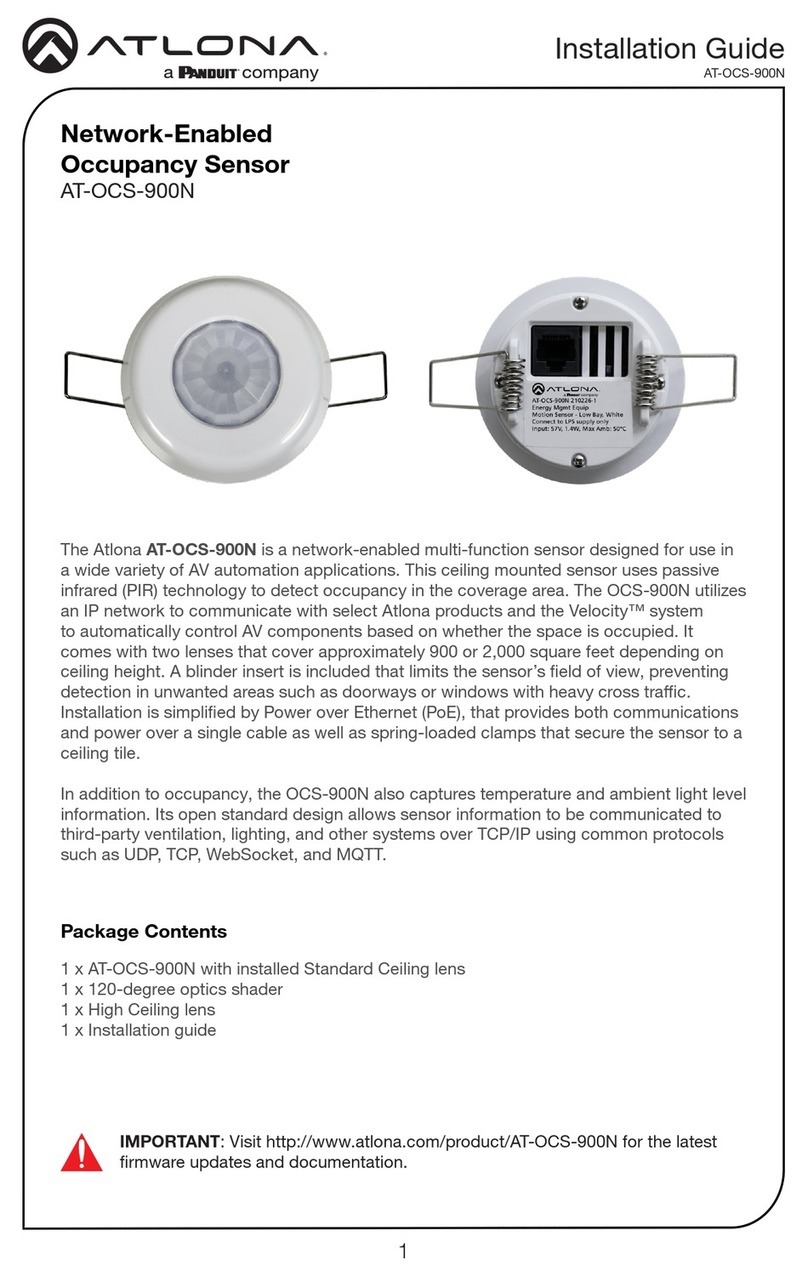
Panduit
Panduit Atlona AT-OCS-900N installation guide
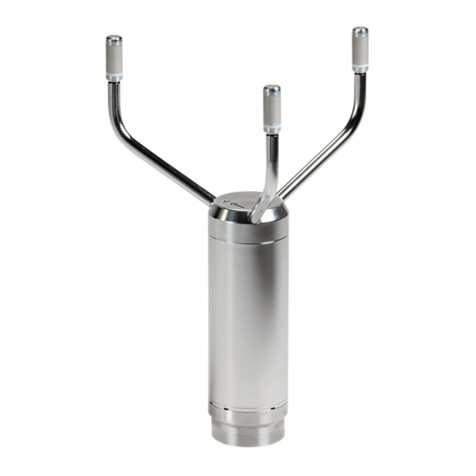
Vaisala
Vaisala WINDCAP WMT700 Series user guide
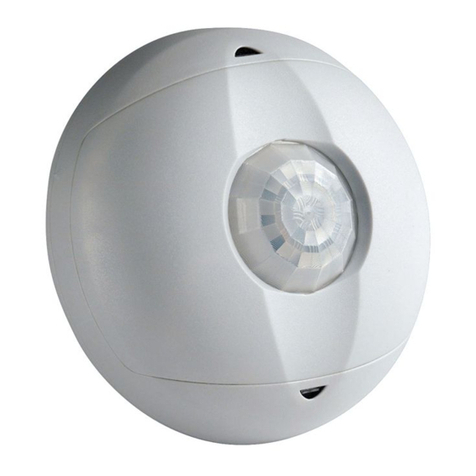
Crestron
Crestron GLS-OIR-C-450 Operations & installation guide
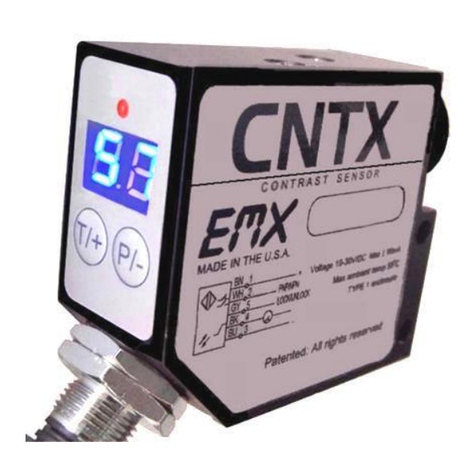
EMX Industries
EMX Industries CNTX Series operating instructions
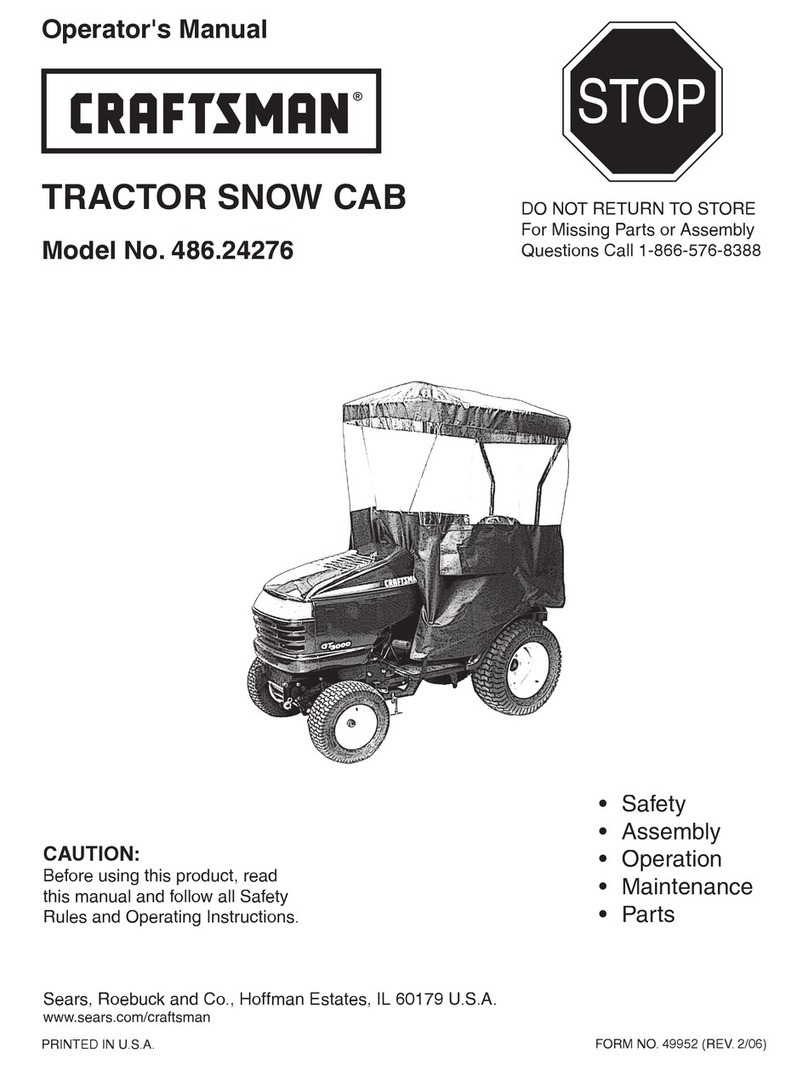
Craftsman
Craftsman SNOW CAB 486.24276 Operator's manual


